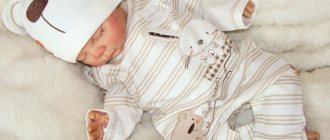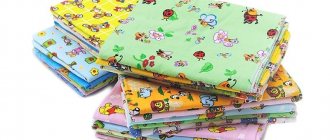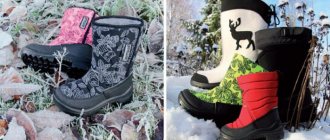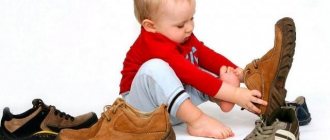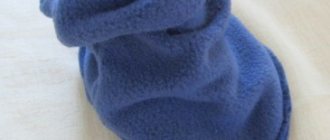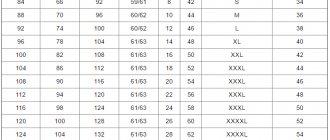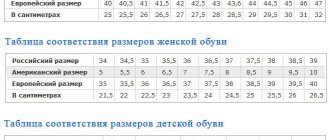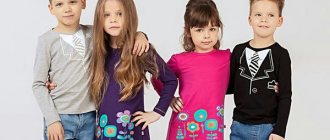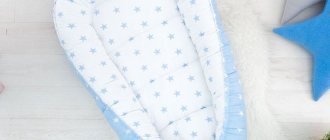Booties for newborns can be knitted (cotton and wool) or fabric, leather, fur. They are worn on thin socks.
Babies under one year old are usually dressed in booties for warmth during walks when the baby is sitting in a stroller. Light fabric or cotton knitted booties can be worn at a temperature of 22°C, and at a temperature of 15-18°C you will need warm booties, wool or leather. At lower temperatures, newborns are dressed in a demi-season overalls or blanket. Overalls for babies up to one year old cover their entire legs or booties are included.
Often, newborns wear booties for a visit to the clinic for hygienic reasons. They are also worn for beauty in addition to a suit or elegant dress.
Babies 10-11 months old are dressed in leather booties with flat soles so that they get used to shoes. At 10-11 months, children learn to walk and at this time it is appropriate to teach them to wear shoes - first, booties that look like shoes or boots.
The sizes of booties are designated differently. Most booties are sized according to the European line mass system, like children's shoes. Sizes 17 to 19 are common, while 16 and 20 are less common. The bootie size chart is shown below.
We list American and English sizes of booties in the following table.
Many manufacturers indicate the size of booties in centimeters, corresponding to the size of a newborn’s foot. So sizes 10, 11, 12, 13 correspond to foot lengths of 10 cm, 11 cm, 12 cm, 13 cm.
Previously, according to the Russian standard, the sizes of children's shoes and booties were indicated in millimeters with a size grid every 5 mm. Until now, some Russian manufacturers adhere to these designations. Russian size 100 means foot length 100 mm = 10 cm. For clarity, here is a table of Russian sizes of booties.
It happens that the manufacturer designates the size by age in months or by letters or numbers according to their size charts. For example, a fairly common letter size scale:
In online stores or on the packaging of booties, the length of the insole or the length of the foot is often indicated in addition to the size. If only the age of the newborn is indicated in months, then the manufacturer is guided by the average size of the baby’s feet. For your convenience, we provide a table of the correspondence of foot length to the age of the newborn by month.
Foot length is measured from the heel to the tip of the big toe along the foot. It is convenient for a newborn to measure the foot while sleeping. Trace the outline of his foot in a thin sock (in which he will wear booties) on a piece of paper, then measure its length. You can take booties-socks exactly according to the size corresponding to the length of the foot, and calculate the size of booties-shoes by adding 0.5 cm to the length of the foot for freedom of movement. Remember that a newborn’s foot grows quickly and in 1.5-2 months he will need new booties. Consider the height of your child’s feet when ordering shoes from foreign online stores with long delivery times.
Booties have different fasteners: elastic, Velcro, laces. The clasp should not be tight, but strong, so that it is not easy for the baby to throw the booties off his feet.
All parents approach the choice of shoes for their child with great responsibility. A lot depends on the quality of shoes - the baby’s mood, correct gait, and foot development. Therefore, before you go shopping at a children's shoe store, all experts recommend deciding on a model and choosing only high-quality shoes made from natural materials. plays a huge role in the correct choice of children's shoes .
It is known that children grow very quickly and many items from their wardrobe only have time to wear a few times. The same applies to shoes - children's feet grow rapidly during the first years of life, so parents have to change shoes, sandals and boots very often. And since high-quality children's shoes are not cheap, it is important to purchase the most comfortable pair that matches the child's foot size.
How to find out your child's foot size?
For most parents, this question is a difficult one. Often, inexperienced mothers and fathers determine the size of a child’s feet incorrectly.
The most common mistakes that parents make when trying to find out the size of their child’s feet:
- When buying shoes, they ask the child for advice: “Does the heel or toe press?” Children, as a rule, are much less susceptible to such factors. Therefore, it is quite likely that the child will answer “No,” but in reality it will be the other way around. Children first of all pay attention to the color of shoes and their shape. This determines their choice.
- When buying shoes, they try to determine the size of the child’s feet by applying the sole of the model they like to his foot. It should be remembered here that the dimensions of the sole and inner insole can vary significantly. In this situation, there is a high probability of purchasing tight shoes for the baby.
- When choosing shoes, they try to squeeze a finger between the child’s heel and the heel. The child can tuck his toes, and the shoes will seem suitable to the parents. And only during the first walks will it be possible to determine the mistake with the size.
For those parents who do not understand children's shoes at all, there is a special table for the child's foot size by age. Thanks to this table, you can determine the approximate size based on the baby's age. Parents should be aware that all values are averages; significant deviations from the figures given below often occur.
Child foot size chart by age
presented below.
| Age | Foot length | Size | |
| Inches | |||
There are several methods for determining the size of a child's feet.
Here are some of them:
- Parents need to trace the baby's foot with a pencil and measure the distance from the heel to the tip of the big toe. The resulting figure represents the child's foot size.
- Place the tape measure under the child's foot, hooking its end onto the child's big toe.
- It is necessary to wet the foot with water and leave a mark on an easily wet surface, then measure the distance from the heel to the big toe on the left mark.
Reference table for approximate shoe sizes
metric and mass systems (GOST 11373-88)
M - metric measurement system (size is considered to be the length of the foot in mm)
W - mass measurement system (size is considered to be the length of the foot in inches (1 length = 2/3 cm))
When buying any shoes - for summer or winter, parents should remember that the child will outgrow this pair quite quickly. Therefore, it makes no sense to purchase sandals or boots back to back. You should always leave a small reserve for growth.
Choosing the right shoes is always a difficult task, which is especially difficult if a small child needs shoes. The length of a child’s foot will differ from month to month, and although visual changes will be insignificant, this will greatly affect the shoe size.
What changes are happening?
After the birth of a child, the leg goes through several stages in the process of formation. In this regard, it is very important to monitor how it changes. And the question is not only in the choice of shoes, the baby may develop orthopedic diseases that bend the small leg. Because of this, it often turns out that the first changes towards flat feet occur, and parents do not notice it.
In the first years, a child's leg consists mainly of cartilage; over the years, they turn into bone tissue. And despite the fact that modern shoes are maximally tailored to the characteristics of the child’s body, it is necessary to periodically visit an orthopedist after 3-4 years to check whether the leg is normally formed. If there were prerequisites for the appearance of orthopedic diseases at birth, then such examinations begin much earlier. It is also worth going to the doctor if you yourself notice that your foot is not forming correctly.
The development of a child’s foot occurs individually; it is worth measuring a newborn’s foot no more than once every 3 months. It is read that it is during this time that its increase occurs. In addition, it is important to monitor how a child’s foot changes from 1 to 3 years old. When a child turns three years old, feet can be measured less frequently; after 6 years old, this can be done once every six months.
Booties
First, let's talk about booties. They can conditionally be called shoes, since they serve mainly for beauty or warmth. Children wear booties from birth until the moment they begin to stand up on their own. There is no great need for them, so do not buy booties before the baby is born.
Later you can decide how much you need them. Booties may be needed during a walk so that the baby, who is already sitting in a stroller but does not yet know how to stand up, does not sit in only socks. It is more convenient to buy booties with laces, since shoes with Velcro are held less tightly, and babies take them off.
When should you buy real boots?
We buy boots for the baby as soon as he starts to stand up. This is necessary in order to immediately correctly fix the child’s leg. The baby should wear shoes not only on the street, but also at home.
How to determine foot length?
It is customary to measure a newborn’s foot with either a tape measure or a thread. If you choose the second method, then simply attach this thread to a ruler and find out the length of the foot in centimeters. Typically, a newborn’s foot is measured this way until he begins to stand on his feet.
When the child is older, the foot is measured in a different way. The child's feet are placed on a blank sheet of paper and outlined with a pencil. And after that, the pattern is measured in length; if necessary, then the width of the foot is determined.
To avoid tracing, you can leave a wet print on the paper. To do this, you need to wet your foot, and then the child just needs to stand on a piece of paper. There is a chance that one leg will be a little longer, don’t be upset, just focus on the larger figure when choosing shoes.
You should also remember about the features of the summer period. When choosing summer shoes, you should take the size of your child’s feet and add about half a centimeter to it. This is done taking into account the fact that in the heat the foot swells and the shoes may be tight. If you choose winter shoes, this does not happen, but here you need to take into account the fact that you will be wearing a sock, accordingly, you need to add 1-1.5 cm.
How does a leg grow over the months?
Despite the fact that each newborn may have its own characteristics of body development, in pediatrics there is a kind of table that indicates the normal length of a child’s foot by month of life.
If you measure a child’s foot by month from birth to one year, the parameters will be as follows: up to 3 months – 9.5 cm; from 3 to 6 months – 10.5 cm; from 6 to 12 months – 11.7 cm.
Children aged one and three years will have the following foot parameters: from 12 to 18 months – 12.5 cm;
From 18 to 24 months – 13.4 cm; from 24 months to 36 – 14.7 cm. Three-year-old child – 15.2 cm.
When a child reaches the age of 4 years, the leg will be approximately 17.3 cm in length, while for a five year old it will be 18.4 cm.
Table of Russian sizes of booties
| Size, Russia | 100 | 105 | 110 | 115 |
| Foot length in cm | 10 | 10,5 | 11 | 11,5 |
| Size, Russia | 115 | 120 | 125 | 130 |
| Foot length in cm | 11,5 | 12 | 12,5 | 13 |
Sometimes you can find booties on sale where, instead of the size, the age in months for which they are intended is indicated. Manufacturers may also use a letter scale.
Shoe size
In stores, none of us have seen shoe sizes written according to foot length, so you need to know what shoe size a six-month-old baby will wear. There are European sizes, which we are more used to, since they are indicated on all our shoes, but there are also American shoe sizes.
For children of different ages, the following European shoe sizes will correspond:
- up to 3 months – 16-17;
- 3-6 months – 17-18;
- 6-12 months – 19;
- 1-1.5 years – 20;
- 1.5-2 years – 21-22;
- 2-3 years – 23-25;
- 3-4 years – 25-27;
- 4-5 years – 27-29.
US shoe size:
- up to 3 months – 0-2;
- 3-6 months – 2.5-3.5;
- 6-12 months – 4-4.5;
- 1-1.5 years – 5-5.5;
- 1.5-2 years – 6-6.5;
- 2-3 years – 7-8.5;
- 3-4 years – 9-10.5;
- 4-5 years – 11-12.
In a person, his lower limbs develop individually, therefore the size of the leg is different for everyone, for some it will be 36, and for another 45, so do not despair if, according to the table, the leg should be 15 cm, but it is already 16. The main thing is to choose shoes in which the baby will be comfortable, and at the same time they will not spoil the still developing foot.
Bootie sizes: what to pay attention to
It is very important to choose the right size booties. There are different designations. Currently, most models are marked in European sizes. And then there are products with numbers 16,17,18,19 or 20. You can decide whether they are suitable for you by using special tables on the Internet. There you will find what foot length each size corresponds to.
Separately, mention should be made of Russian sizes of booties. Usually they are indicated immediately in centimeters or millimeters. Everything is much simpler here: if the baby’s foot length is 120 mm, then he needs booties of size 120.
Mistakes when choosing shoes
People cannot always choose suitable shoes for themselves at the age of 20-30, let alone select shoes for a child. Of course, at this age, parents select shoes, and they are the ones who can make mistakes in choosing them.
In a store you can see the following picture: they put a shoe on a child’s foot and ask whether it feels tight or not. It would seem to be a completely logical question in the process of choosing shoes, but until the age of three, a child’s limb is not yet formed, and therefore sensitivity is lower than usual. The baby simply does not understand whether the shoes are tight or not.
Parents try to please their child and buy the most fashionable and popular things; cartoon characters are of great interest to children. A child may say that a shoe is comfortable only because it has his favorite character on it.
It is also not recommended to place shoes on a child's foot. Each manufacturer makes shoes with different features, and if you chose some shoes and they fit, then others may be tight.
You should not buy shoes that fit one to one, as they will become small in 7-10 days. But this does not mean that you need to buy shoes 5 sizes larger, just buy shoes with a small margin. This approach will allow you to avoid harming your feet and wear these shoes for at least a season.
Some mothers buy branded and expensive shoes for their children; in fact, there is little point in this. Shoes should be of high quality, but not necessarily branded; your feet will grow in a couple of months and such shoes will simply be unnecessary.
It is best to choose shoes based on foot measurements, which are recommended to be taken after swimming, when the blood vessels are dilated and the foot acquires the largest possible size. This way, the shoes won't be tight and won't be a useless purchase.
You must agree that it is not an easy task to go shopping with your baby and choose the right shoes for him. Undoubtedly, all children love new clothes, but have you ever seen one child who, after two hours of shopping with his mother, remains in a good and joyful mood? In addition, after trying on several pairs of shoes, it is difficult for a child to objectively assess which pair of shoes is the most convenient and comfortable. Therefore, in order to avoid children's tears and mother's nerves, parents postpone going shopping with their child. Thanks to online stores, the task of choosing children's shoes has become much easier. Parents no longer need to go to shoe stores with their child, just sit down at the computer monitor and open a couple of suitable online stores. But to make a successful purchase, you must first choose the right size of children's shoes.
It is known that children grow very quickly and many items from their wardrobe only have time to wear a few times. The same applies to shoes - children's feet grow rapidly during the first years of life, so parents have to change shoes, sandals and boots very often. And since high-quality children's shoes are not cheap, it is important to purchase the most comfortable pair that matches the child's foot size.
And if a table is used to calculate the foot size, then it should be taken into account that each baby is individual, and the size of his foot may also differ from the indicators contained in a special dimensional grid. To choose the right shoes, you should take into account age (both year and month are taken into account), height, foot length
Requirements that the first shoe must meet:
- It is desirable that the shoes be made of natural materials both outside and inside (leather, textiles).
- Shoes must be high enough to support the ankle. Lace-up boots are best for this purpose, as the laces secure the foot well.
- The heel of the boot should be rigid, solid, with a rounded top to protect the foot from chafing.
- Choose shoes with small (about 0.5 cm) heels.
- The toe should be wide, rounded, slightly raised.
- The first boots should be about 5-10 mm larger than your feet. If you buy boots that are larger, your feet will dangle in them.
- Shoes with stedators can only be purchased after consulting a doctor.
As can be seen from the table, the smallest size is 17. But there are cases when the child has very small feet and appropriate shoes are not available for sale. In this situation, you can put cotton wool in your sock.
When you buy children's shoes, always measure the insole size. Very often, shoes from even the most famous manufacturers do not correspond to the size indicated on the packaging.
Never buy shoes that put pressure on your baby's instep or toes. Do not put tights or socks on your child that are too small. It is advisable that the shoes have flexible soles so that the foot can move.
How to find out your child's foot size?
For most parents, this question is a difficult one. Often, inexperienced mothers and fathers determine the size of a child’s feet incorrectly. The most common mistakes that parents make when trying to find out the size of their child’s feet:
- When buying shoes, they ask the child for advice: “Does the heel or toe press?” Children, as a rule, are much less susceptible to such factors. Therefore, it is likely that the child will answer “No,” but in reality it will be the opposite. Children first of all pay attention to the color of shoes and their shape. This determines their choice.
- When buying shoes, they try to determine the size of the child’s feet by applying the sole of the model they like to his foot. It should be remembered here that the dimensions of the sole and inner insole can vary significantly. In this situation, there is a high probability of purchasing tight shoes for the baby.
- When choosing shoes, they try to squeeze a finger between the child’s heel and the heel. The child can tuck his toes, and the shoes will seem suitable to the parents. And only during the first walks will it be possible to determine the mistake with the size.
For those parents who do not understand children's shoes at all, there is a special table for the child's foot size by age. Thanks to this table, you can determine the approximate size based on the baby's age. A table of child's foot sizes by age is presented below. Parents should be aware that all values are averages; significant deviations from the figures given below often occur.
| Age | Foot length | US size | European size | |
| Inches | Cm | |||
| 0-3 months | 3,7 | 9,5 | 0-2 | 16-17 |
| 0-6 months | 4,1 | 10,5 | 2,5-3,5 | 17-18 |
| 6-12 months | 4,6 | 11,7 | 4-4,5 | 19 |
| 12-18 months | 4,9 | 12,5 | 5-5,5 | 20 |
| 18-24 months | 5,2 | 13,4 | 6-6,5 | 21-22 |
| 2 years | 5,6 | 14,3 | 7 | 23 |
| 2.5 years | 5,8 | 14,7 | 7,5-8 | 24 |
| 2.5-3 years | 6 | 15,2 | 8-8,5 | 25 |
| 3-3.5 years | 6,3 | 16 | 9-9,5 | 26 |
| 4 years | 6,7 | 17,3 | 10-10,5 | 27 |
| 4-4.5 years | 6,9 | 17,6 | 11-11,5 | 28 |
| 5 years | 7,2 | 18,4 | 12 | 29 |
In addition to the table, there is another method for determining the size of a child’s feet. To do this, parents need to circle the baby's foot with a pencil and measure the distance from the heel to the tip of the big toe. The resulting figure represents the child's foot size. This system for measuring leg size is common in the former CIS countries. In Western Europe and America, the so-called stichmass system for measuring the size of a child’s feet is used. Each pair of shoes indicates the length of the inner insole in pieces (1 piece = 2/3 cm).
Size range of various manufacturers
To select shoes, sneakers and sandals from various brands, manufacturers recommend using special nets that their company provides. Below you can find tables of popular brands of children's shoes.
Kotofey
This brand produces sneakers and trainers for children of all ages. It is distinguished by convenience and quality.
Crocs
produces both fashionable and comfortable shoes for children of all ages. The company uses a special material – Croslite – in the production of winter and demi-season products. Thanks to it, the shoes accept and maintain the body temperature of the baby’s feet, which is its undoubted advantage. Crocs can be chosen for a boy or a girl in accordance with the following table.
Adidas
Few parents have not heard of such a popular brand as Adidas. The company has held a strong position in the global market for decades. Their products are popular in all countries. The size scale is below.
Skorokhod
The Russian company produces children's shoes for various ages. Boots, sneakers, sandals and shoes of this brand are environmentally friendly and of excellent quality. To select shoes for children from 6 to 12-14 years old, you should use the following table of correspondence between the metric and weight systems.
Fairy tale
Reviews from many parents indicate that shoes from the Skazka brand are at least one size larger. To choose the most comfortable shoes and boots, you should use the sizing chart of this particular company. You can find it below.
Nike
The sports company Nike offers a wide selection of shoes for adults, teenagers and children. To select sneakers, sandals and sneakers, you should use a special table.
Ekko
The international company Ecco is a reliable manufacturer of adult and children's shoes. Its products have conquered the whole world and for many years the brand has not given up its position. The Ecco size scale is provided below.
Zebra
offers parents high-quality and environmentally friendly shoes. To create it, special technologies are used to make comfortable shoes, sandals, and sneakers for children. Below is the size chart.
It is impossible to say for sure which manufacturer is better. Parents should select shoes for their child, taking into account the individual characteristics of their son or daughter, and also taking into account the pricing policy of a particular company.
Features of shoe sizing charts in different countries
- In Russia and CIS countries. The accepted size range is in millimeters. The foot is measured from the extreme points: the protruding part of the heel and the protruding toe, usually the big one. In this case, decorative allowances are not taken into account.
- In Europe. The European size chart of shoes for children coincides with the Russian one.
- In England. The foot is measured in inches (1 inch = 2.54 cm). The first size for a newborn is 0. The count starts 4 inches from the heel. The sizes change in 1/3 inch increments: from 0 to 13 and from 1 to 13.
- In China. As in Russia and Europe, the size chart is focused on the length of the foot.
- IN THE USA. As in England, Canada, Australia, the foot is measured in inches, with a shift to zero by 1/12 (2.1 mm).
- In France. Here the sizing chart is based on the length of the insole. The French measurement system is characterized by a unit of mass, which is 2/3 cm (1 item). The stichmass system often causes confusion because the length of the insole and the foot are mistakenly mixed up.
How fast does the leg grow?
Babies grow quickly, and children also have developmental spurts when their height and weight rapidly increase and, accordingly, their legs grow. Because of this, you may need more than one pair of sandals or boots for one season. Then you can come to the store with a pair that has been worn out for several months and just take a size larger. But you need to be careful: the sizing chart may differ from different manufacturers. For some, size 19 is 11 centimeters, for others, for example, 12. Moreover, even in different lines from the same company there are noticeable differences, so the general table is not always reliable. Careful measurements are also needed when purchasing children's shoes in online stores. Not all of them provide the opportunity to try on and immediately change the chosen pair. So we have to study the necessary values. You must also remember that the smaller the child, the faster his leg grows. Up to 3 years, the size changes on average every 3 months. Children's shoes are usually enough for one season, no more. Although it happens that size 21 sandals, which fit perfectly at the beginning of summer, are too small already in the middle of summer. From 3 to 6 years old, the leg usually grows one size in 4 months, after 6 years - in 5 months.
When buying any shoes - for summer or winter, parents should remember that the child will outgrow this pair quite quickly. Therefore, it makes no sense to purchase sandals or boots back to back. You should always leave a small reserve for growth. As a rule, children's shoes are worn for no more than one season. Therefore, if you have limited financial resources, you should not buy expensive branded shoes - they will not last long for your baby. Choosing children's shoes needs to be done very responsibly. So, make sure that the shoes do not squeeze the baby’s feet and are not too big. If the child is small and cannot yet tie his shoelaces, give preference to shoes with Velcro or zippers.
How to choose your first shoes
When choosing shoes for a baby, you need to follow certain rules:
- There should be fastening fasteners. With their help, it will be easier to adjust the width of the boot cavity for the child, depending on the thickness of the sock used.
- Be sure to have a high heel, even if you plan to take summer sandals.
- You should not take shoes larger than the required size. This will only make it more difficult to walk and maintain balance.
- Consider the rise of the child's foot. An infant should not be given very high boots.
- The toe of the boot should be round.
- Pay attention to the season and weather. For example, in the warm season, sneakers are more suitable for a child, but when it gets colder, he will need warm boots.
Advice! Rigid, supportive shoes will be most useful for infants under 3 years of age. If the need for it disappears before this time, there is nothing wrong with that.
Common mistakes parents make
There are 4 common mistakes that inexperienced parents make when choosing children's shoes:
- Putting shoes on a newborn ahead of schedule. You should choose your child’s first shoes no earlier than 9-12 months from the moment of birth, when he has already learned to walk. In this case, a newborn should wear shoes only during street walks.
- Wearing someone else's shoes. Because each baby wears them out differently, wearing old boots will have a detrimental effect on your newborn's foot development.
- During the fitting process, you should not place your finger between the back and the newborn’s foot to assess the stock. In this case, children begin to curl their toes, which creates additional free space.
- You can’t buy shoes “back to back.” Children at a young age grow extremely quickly.
First shoes
When should a child wear his first shoes? The first sandals or boots are bought when the baby starts walking. There are different opinions of specialists on the issue of arch supports. Some say this is a commercial trick. And if the child develops normally, the orthopedist does not see any pathologies, then you can buy shoes without arch supports. Others believe that arch supports are needed to prevent flat feet. What should a child's first shoes be?
- It should have 2 or 3 fasteners to secure the foot well.
- You need to leave a margin of at least 1 cm to the edge of the sole.
- Summer sandals and shoes should be true to size, have a high heel, and no cutouts - all this to ensure good support for your feet when walking.
- Winter boots can be a size larger.
- The nose should be round for safety so that the baby does not catch on his socks.
At home, it is recommended that your baby walk on a soft surface with shoes on. It is useful to walk barefoot on hard surfaces. But if the floors are slippery and the child is wearing socks, this is unsafe. In this situation, you need to purchase anti-slip socks.
What size can a child's feet be in a year? According to standards from 19 to 21 sizes. Girls at this age usually have smaller legs, often 18 or even less. Winter shoes can be from 20 to 23 numbers.
Does a newborn need shoes - the opinion of Dr. Komarovsky
According to Evgeniy Komarovsky, a newborn should learn to walk without shoes, especially since the human foot is created specifically for walking barefoot . So you don’t need any special shoes for the first step. And only when the baby begins to walk ⛵️ tolerably, he can be put on shoes. It is worth keeping in mind that shoes themselves do not correct anything and do not affect how quickly a child learns to walk. It is needed only for protection from cold and mechanical stress.
Therefore, first of all, it is worth purchasing ❄️ winter shoes. For the summer, you will need boots made of breathable material so that the child’s feet are not trapped in them.
When you really need shoes
Theoretically, a baby will only need his first shoes when he starts going outside ☔️. All children who have just begun to walk have an unsteady and unsteady gait, and their foot propulsion is not sufficiently developed. This is partly explained by the limited functions of the not fully formed ankle. A newborn will be much more comfortable in high shoes that fix and support the feet.
How to tell if shoes are too small
An older child may complain that the shoes are tight, crushing, or rubbing, but small children will not talk about this. How do you know when it's time to move up to the next size of children's shoes?
- It is necessary to examine the baby's feet after closed shoes are removed. If there is redness, marks on the body, toes are bent, the shoes do not fit either in fullness or in length.
- Press the toe with your finger. There should be some space between the edge of the shoe and the big toe. Its permissible norm in young children is 1.5 cm.
- Pay attention to the backdrop. If the shoe is small, the heel will be slightly stretched, protruding from the back, on the outside and inside of the shoe.
- Pay attention to the top of the shoe. The upper part should not be too tight or fit too tightly to the leg. There should be a small gap between your foot and the tongue of the boot.
Children's feet grow quickly, so they need to be measured periodically. Children under 1.5 years old need to measure their foot length once every three months. Children from 3 to 7 years old should have their foot length checked every 5-6 months. Children over 7 - once a year. During adolescence, there is a growth spurt and the leg can grow rapidly. We also must not forget about the height, constitution, gender of the child, and hereditary factors.
A child's shoe size by age is a conventional scale. The most important parameter in the sizing chart is foot length. To make an error-free choice, you must measure your foot correctly. It is also important to consider the size range of a specific manufacturer.
How to buy shoes correctly
♻️ When buying boots for your child, you need to pay attention to the following:
- You should not buy models with an open heel until the baby is over 5 years old, otherwise this will have a detrimental effect on the formation of the child’s ankle.
- Children's shoes must have an instep support.
- The sole should be chosen only corrugated and made of porous rubber.
- You should not take children's shoes with flat soles, otherwise you can ruin the baby's gait and posture.
- The toe of a shoe for a newborn must be wide so that his toes can be placed there quite freely.
